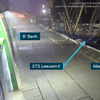GPA Marks 13 Percent 1Q Growth
Harbor deepening moves into construction phase.
On the heels of a state-federal agreement allowing the Savannah Harbor deepening to begin, the GPA has posted nearly 13 percent growth in container traffic for the first quarter of the fiscal year.
"September's outstanding cargo volume continued a trend of double-digit growth," said GPA Executive Director Curtis Foltz. "Important investments in infrastructure, including the harbor deepening, new equipment and roadways are helping to position Savannah for additional growth."
Since July, the Port of Savannah has moved 891,408 twenty-foot equivalent container units (TEUs), an increase of 102,122 units. September cargo grew at the same rate, with the Port of Savannah moving 295,698 TEUs, up 33,876 (12.9 percent) compared to the same month a year ago.
Release of the positive cargo numbers comes after the signing of a cost sharing agreement between Georgia and the U.S. Army Corps of Engineers Wednesday, allowing the state to use the $266 million it has set aside to start construction.
"Every budget I have submitted and signed into law has included money for the state share of the deepening," said Georgia Gov. Nathan Deal. "My most recent budget included Georgia's final commitment, allowing this project to move forward now. Georgia has been ranked the top state in the U.S. for business by three different scoring agencies, and this expansion project will play a crucial role in ensuring our state maintains that top distinction."
As the expansion moves forward, construction funding will shift to federal dollars.
"SHEP is truly a project of national significance," said GPA Board Chairman James Walters. "The Port of Savannah handles more than 3 million twenty-foot equivalent container units per year for more than 21,000 U.S. businesses - the second busiest port on the East Coast."
By deepening the Savannah River, SHEP will enable the port to more effectively serve the larger vessels expected to call in greater numbers after the 2016 expansion of the Panama Canal. The expansion will deepen the harbor from 42 to 47 feet at low tide. A twice-daily tidal swing of 7 feet will make the river 54 feet deep at the high tides. The entrance channel, which extends into the Atlantic, will be dredged from 44 to 49 feet at low water. Bids are due to the Corps of Engineers on the entrance channel dredging contract by Oct. 29.
"Savannah offers the complete logistics package, with direct interstate access, on-terminal rail, near-port distribution centers and a location that is 100 miles closer to Atlanta than any other port," Foltz said. "Port customers already enjoy world-class efficiency on terminal and easy access to important inland markets. The harbor deepening will add game-changing savings in time and transit costs to the sea-going side of the operation."
The Corps' economic impact study found that every dollar invested in the deepening will generate 5.5 dollars in benefits to the nation. "With the PPA signing, Savannah has joined this movement toward a new standard in global trade," Foltz said.
The harbor expansion is one facet of a long-term plan for growth, Foltz said, adding that 9,600-TEU class vessels are already calling on the Port of Savannah. "By employing the most efficient machinery, maximizing land use on our existing footprint, and making the required additions to infrastructure, we are steadily expanding our capabilities, with a capacity goal of 6.5 million TEUs by 2024."
Capital improvement plans include increasing the number of ship-to-shore cranes from 22 to 30 and rubber-tired gantry cranes from 116 to 169. Meanwhile, the state Department of Transportation will complete the Jimmy Deloach Parkway Extension in the summer of 2016 to provide a one-of-a-kind cargo beltway connecting the Port of Savannah directly to Interstates 95 and 16.
"These infrastructure improvements will help us better serve our customers today and into the future," Foltz said.















